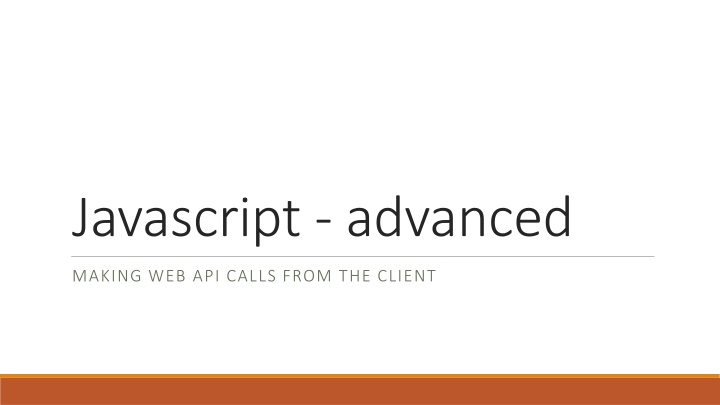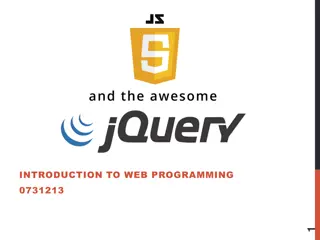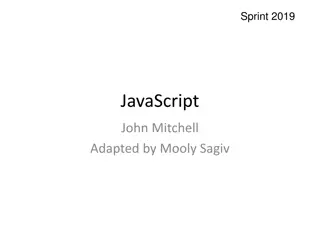
Advanced Javascript Techniques for Making Web API Calls
Learn about advanced Javascript techniques for making web API calls from the client side using AJAX, XMLHttpRequest, jQuery, Promises, and the Fetch API. Discover how these methods can improve website speed, efficiency, and user experience.
Download Presentation

Please find below an Image/Link to download the presentation.
The content on the website is provided AS IS for your information and personal use only. It may not be sold, licensed, or shared on other websites without obtaining consent from the author. If you encounter any issues during the download, it is possible that the publisher has removed the file from their server.
You are allowed to download the files provided on this website for personal or commercial use, subject to the condition that they are used lawfully. All files are the property of their respective owners.
The content on the website is provided AS IS for your information and personal use only. It may not be sold, licensed, or shared on other websites without obtaining consent from the author.
E N D
Presentation Transcript
Javascript - advanced MAKING WEB API CALLS FROM THE CLIENT
Full Stack You can t do this!! Web Server SQL QUERY GET POST Client DB postgresql Data tables Web pages/ React Python client Flask API Endpoints
AJAX and XMLHttpRequest httpRequest = new XMLHttpRequest(); httpRequest.open('GET', 'test.html'); httpRequest.send(); httpRequest.onreadystatechange = function(){ // Process the server response here. // e.g. JSON.parse(httpRequest.responseText); }; AJAX: Asynchronous Javascript And XML Make an HTTP request without refreshing the page Makes websites much faster and less jarring Make lots of small changes to the page e.g. no save button - as soon as you edit a field, send an Ajax call to update the server Notes Be sure to put httpRequest in a closure - avoid some race conditions on multiple simultaneous calls Set Cache-Control: no-cache HTTP header, otherwise the browser will likely cache the request Ajax was the backbone of the Web 2.0 movement(circa 2006) Enables RESTful operations/ verbs
jQuery another way to use AJAX Originally created by John Resig, RIT class of 05, CS Major Was the standard for web development for a long time - largely replaced by React.js, Angular.js, Vue.js, Ember.js Still ubiquitous today. Heavily influenced JS standards today e.g. Fetch API from jQuery s $.ajax Huge ecosystem of plugins In a nutshell: $() $(selector).action() In a larger nutshell: DOM read-write in a compact, concise, readable way Method chaining CSS selection JS looks like HTML, making it easier to read and maintain $.ajax({ type: 'POST', url: '/api/endpoint', data: { name : 'Bono', location : 'Dublin, Ireland', } }).then(function(msg) {..})
Promises const myPromise = (new Promise(myExecutorFunc)) .then(handleFulfilledA) .then(handleFulfilledB) .then(handleFulfilledC) .catch(handleRejectedAny); Object that represents the eventual completion or failure of an asynchronous operation Promises allow for: Cleaner syntax More expressive chaining of operations Better browser optimization Three states Pending Fulfilled Rejected then(), catch(), and finally() allow for complex chains
Fetch API A newer update to Ajax Uses Promises Adheres more closely to CORS and Same Origin policies More secure defaults in general, e.g. more secure cookie handling Simpler API Always finishes Whether the request was successful or not e.g. An HTTP 500 isn t an exception, it s just part of the promise structure Better integration with Service Workers let result = fetch('http://example.com/movies.json') .then((response) => { return response.json(); }) .then((data) => { result = data; console.log(data); }); More complex dependency trees Better async optimization console.log( A new beginning ) console.log(result); Beware! Anything OUTSIDE fetch/then will run asynchronously!
async/ await let result = default ; let response = await fetch('http://example.com/movies.json ) let data = await response.json(); result = data; console.log( A new beginning ) console.log(result); Forces synchronous behaviour Function must be declared async
React and REST (POST and GET example) fetchData = () => { //GET is the default fetch('/getdata') .then(response => response.json() )//The promise response .then (jsonOutput => //jsonOutput now has result { this.formatData(jsonOutput); //Set the data so your component can use it in the page } ) } doPost = () => { fetch('/coursedata', { method: 'POST', body: JSON.stringify({ title: 'New title added', body: 'New body added. Hello body.', userId: 2 }), headers: { "Content- type": "application/json; charset=UTF-8" } }).then(response =>{ return response.json() }).then(json => { this.setState({ user:json }); }); } //Or whatever your API endpoint is We use fetch and promises This allows async API calls, then handle the return data and process as needed
Initialization In javascript we can initialize or set up dynamic behaviour when the page loads In React use initialization events Built-in handlers that you can override e.g. //When component is loaded, get data from backend/ DB via API <body onload= initFunction()"> Or <script type="text/javascript"> window.onload=initFunction(); </script> . function initFunction() { alert( Hello, Sailor! ); } componentDidMount(){ this.fetchData(); } fetchData = () => { fetch('/quotes') .then( (response) => { } Or perhaps, check cookies
Rendering multiple objects {/*inline JS map*/} <div { this.state.myData.map(item => { return ( <MyComponent> {item} </MyComponent> ) } ) } </div> React is built from components Like other O-O languages, components are intended to written once, but instantiated multiple times You do NOT want to do this <MyComponent> myData[0]</MyComponent> <MyComponent> myData[1]</MyComponent> <MyComponent> myData[2]</MyComponent> <MyComponent> myData[3]</MyComponent> That would be hardcoded, and leave you with no way to render 5 objects (or 3, or )
Fetch, Node and Flask The CORS issue Web security frequenetly prevents cross- origin resource sharing (CORS) The intent is to prevent hijacking of web pages/ actions get/index.html get/style.css server1(Node) This is fine normally, but creates a dilemma for us in development if the WebServer and the Application server are not the same In our situation, that is Node (Web Server) and Flask (Application Server) So, without special handling, our Node Web pages are blocked from talking to the Flask APIs! Using client-side fetch triggers CORS get/users get/books server2 (flask)
CORS Preflight If Cross-Origin is detected, an OPTIONS request is sent first Preflighted requests in CORS In CORS, a preflight request is sent with the OPTIONS method so that the server can respond if it is acceptable to send the request. In this example, we will request permission for these parameters: 127.0.0.1 - - [30/Nov/2022 09:17:58] "OPTIONS /quotes HTTP/1.1" 200 127.0.0.1 - - [30/Nov/2022 09:17:58] "PUT /quotes HTTP/1.1" 200 - The server now can respond if it will accept a request under these circumstances e.g. the server response says that: Access-Control-Allow-Origin
React Developer Tools Chrome and Firefox both have React Developer Tools addons. Highly recommended that you install these to make debugging react components simpler. It allows you to debug JSX/Code written using react directly instead of having to debug the resulting generated code. Firefox: https://addons.mozilla.org/en-US/firefox/addon/react-devtools/ Chrome: https://chrome.google.com/webstore/detail/react-developer- tools/fmkadmapgofadopljbjfkapdkoienihi?hl=en
Demo Topics Components State Props JSX






















